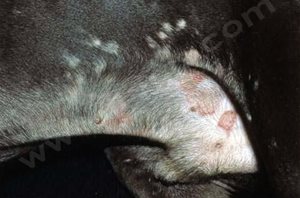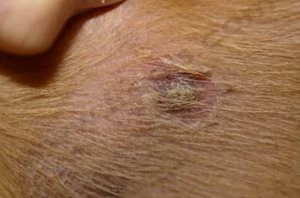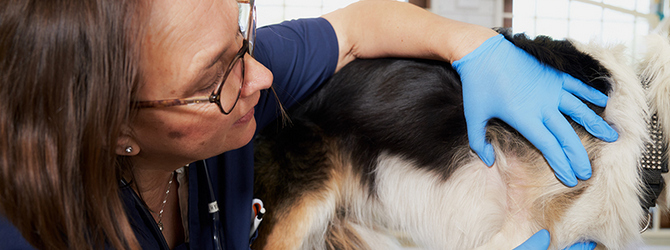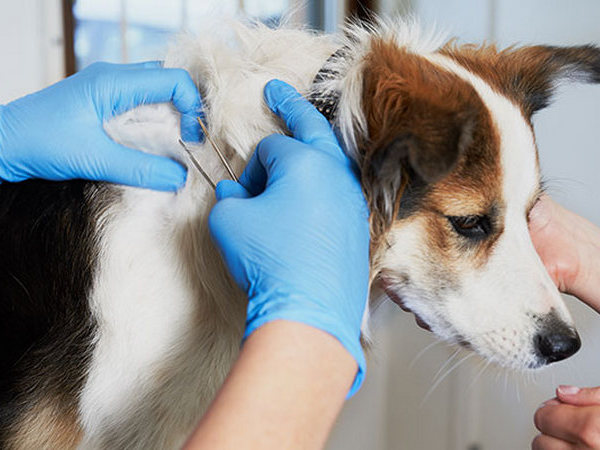Pyoderma in dogs: symptoms and treatment
What is pyoderma in dogs?
Pyoderma is the medical term for a skin infection. It's very common in dogs, and is usually secondary to other problems such as allergies, parasites, inflammation, hormonal disorders, or what are called immune-mediated diseases, where a dog's immune system mistakenly attacks its own cells and tissues. Most of the time, bacteria from the Staphylococcus family is the cause of pyoderma. It's usually found in warm, moist areas like the skin folds around the lips, face, armpits, feet, and neck, as well as pressure points like the elbows.
Brief summary
- Bacterial skin condition predominantly caused by Staphylococcus pseudintermedius
- Can result from underlying skin issues, allergies, or external injuries
- Treatment usually involves a combination of antibiotics and topical therapies, such as medicated shampoos, creams, or ointments
Pyoderma in dogs symptoms
If your dog has pyoderma, which means ‘pus on the skin’, you will probably see scaly, scabby patches on your dog’s skin. As it progresses, the skin can become red and itchy, possibly with bald patches. In shorthaired breeds, it can resemble hives. This is because the inflammation in and around the follicles causes the hairs to stand more erect. In severe cases, called deep pyoderma, you may see ulceration, scabs, a smelly discharge (pus), with darkened and thickened skin in long-term cases.
Pictures of pyoderma in dogs




What causes pyoderma in dogs?
Pyoderma occurs when the skin's natural balance is upset, leading to an overgrowth of bacteria. This may be due to irritations, scratches or wounds to the skin, flea bites, hormonal issues, allergies, hypothyroidism, Cushing's disease, or inadequate grooming. Certain areas, like skin folds and pressure points, are more susceptible to these infections. If the infection is not treated properly, diagnosed accurately, or if the bacteria causing the infection becomes resistant to antibiotics, it can lead to repeated infections.
When should I see my vet?
If you see any signs of pyoderma in your dog, take them to the vet as soon as possible. Early veterinary intervention is really important for effective management of the condition.
How to treat pyoderma in dogs
Diagnosis usually involves a thorough skin examination. The vet might take skin samples to check for parasites under the microscope, and bacterial and fungal cultures to see what organism is causing the infection.
Treatment usually involves a combination of a long course of antibiotics (often for a few weeks) and using special shampoos on the skin. If the infection keeps returning, the treatment might need to be longer. Sticking to the whole course of antibiotics is important to ensure the infection goes away completely. The treatment plan may vary based on the severity and type of pyoderma, as well as the dog's overall health. Skin infections are the main reason for antibiotic treatment in dogs, accounting for up to 30% of all antibiotic prescriptions.
Pyoderma in dogs home treatment
You should speak to your vet if you suspect your dog has pyoderma. If your dog has superficial pyoderma, only use a shampoo suggested by your vet. Human shampoos, including baby shampoos, are unsuitable for dogs as the pH of their skin differs from ours. During the first two weeks of treatment, bathe your dog two to three times a week. After that, you can bathe your dog once a week until the infection clears.
If your dog is diagnosed with deep pyoderma, your vet will likely recommend daily baths with medicated shampoos. Bathing will help remove bacteria, crusts, and scales, and reduce itching, odour, and oiliness. You may not see an improvement for at least 14 to 21 days, and it may take longer for your dog to recover than expected. Your vet can recommend the right bathing program for your dog's condition. For medicated shampoos, it's important to let it remain on the coat for 10 minutes before rinsing to be effective.
Preventing pyoderma in dogs
Pyoderma in dogs is usually secondary to other problems, such as parasites, thyroid disease or other illnesses. Some of these can be difficult to prevent, but there are some ways you can help keep your dog’s skin in the best possible condition.
Regular coat brushing and checks for parasites like fleas and ticks are also essential. Members of Pet Health Club get six-monthly health checks and regular flea and tick treatments as part of their subscription. Eating a balanced diet, keeping wounds clean and managing underlying health conditions that could predispose your dog to pyoderma are also important. Maintaining a clean home and washing bedding regularly are other key preventative measures.
Keeping your dog's hair clean and clipped is also important to prevent skin infections. Professional grooming is advised for medium to longhaired dogs already diagnosed with a mild skin infection. For dogs with deeper skin infections, a shave is recommended. This will help remove excess hair that can trap bacteria and debris.
Is pyoderma in dogs contagious?
No, pyoderma isn't contagious between dogs or from dogs to humans.
Are certain breeds more at risk?
While all breeds can be affected by pyoderma, certain breeds like Airedale Terriers, French Bulldogs, and German Shepherds are more commonly affected. Some breeds may have a genetic predisposition to pyoderma.
What's the difference between pyoderma and dermatitis?
In short, dermatitis in dogs usually comes from allergies and leads to itchy, inflamed skin. Pyoderma, on the other hand, is a skin infection caused by bacteria, often happening because of dermatitis or other problems.
Any studies into pyoderma?
In one study called Canine superficial pyoderma and therapeutic considerations, it was found that Staphylococcus pseudintermedius is often behind skin infections in dogs. The study emphasises the need for careful and correct diagnosis, as this skin issue can look like other conditions. It also discusses the difficulty in treating cases where bacteria resist common antibiotics. The recommended treatment includes both oral medications and skin treatments like special shampoos.
In another study titled Strategies for Management of Recurrent Pyoderma in Dogs, recurrent skin infections in dogs are often linked to staphylococcal bacteria. Identifying the cause can be challenging, and treatments typically include antibiotics, antibacterial shampoos, immune-modifying drugs, or prolonged medication courses for stubborn cases.
In a third study named Therapeutic Management of Canine Pyoderma, 10 dogs with severe skin infections and itching were treated successfully. The dogs received a type of antibiotic injection and a skin wash with a special antiseptic. This combination led to all the dogs recovering completely, showing that using both an injection and a skin treatment can be effective for dog skin infections.
 Need more advice on pyoderma?
Need more advice on pyoderma?
If you need further advice, get in touch with your vet – they’ll always be happy to help.
Find your nearest vet using our find a vet page, or speak to a vet online using our video vets service.




